Peony Glossary
Terms A-G

anther
A flower structure best described as an enlongated vessel which holds pollen. Found at the top of the filaments, they are often yellow in coloration are lance shaped. Some flowers do not have these structure – most often double form flowers.

asexual
Meaning reproduction without sex. This often refers to vegetative propagation. Division, tissue culture and grafting all produce identical plants through asexual reproduction. No pollen (male) or ovules (female) were involved to produce new plants.
Image: Herbaceous peony division

blotch (obverse blotches)
Flares are found on the face of the petals, but there are also blotches on the reverse side of petals in some herbaceous hybrids and woody peonies. Lacking a better term, and wanting to distinguish these from the flares found on the front side of petals, they will be called obverse blotches. Often these obverse blotches are more lightly coloured than the surrounding area and they seldom contribute much in the way of beauty

bud - axillary
A vegetative bud found in the axil of a leaf. An axil is the place in which the leaf is joined to the stem. These are sometimes referred to as secondary buds. Associated with woody (tree) peonies and Itoh group peonies.
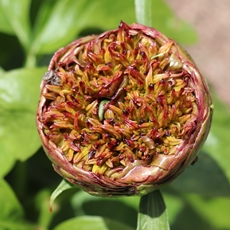
bud - "bullhead"
This typ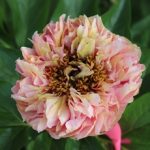 e of bud lacks bud covers and petals do not protect reproductive structures during formation. Since the interior of the flower is not protected from environmental factors (namely water & fungi) these buds often rot before opening. Double herbaceous hybrids are most prone to this, presumably due to having more petal mass. While this anomally is genetic, it may be expressed more commonly in certain environmental conditions. Hybridizers may want to avoid using plants expressing this trait, as offspring may continue to exhit the trait.
e of bud lacks bud covers and petals do not protect reproductive structures during formation. Since the interior of the flower is not protected from environmental factors (namely water & fungi) these buds often rot before opening. Double herbaceous hybrids are most prone to this, presumably due to having more petal mass. While this anomally is genetic, it may be expressed more commonly in certain environmental conditions. Hybridizers may want to avoid using plants expressing this trait, as offspring may continue to exhit the trait.

bud - flower
A floral bud containing reproductive structures of the plant. Refers to an unopened flower. Depending upon the cultivar, some peonies may grow side buds which most often bloom after the primary or main flower bud. In cutflower production side buds are often removed, which directs more energy in bud formation to the larger primary bud. Side buds are often smaller and express less doubleness in double formed flowers.

bud - vegetative (dormant bud)
A dormant bud containing plant structures which may grow into new stems, leaves and flowers in the coming growing season. These buds are produced on crown tissue in peonies. Often referred to as “eyes”. Peonies produce numerous vegetative buds, not all will become new growth/stems. Buds are most well developed in the fall of the season, but are present throughout the year in smaller, less obvious forms.
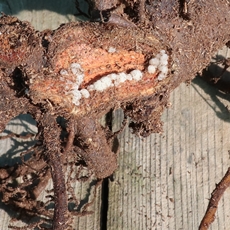
callus and callusing
A term used to describe the feature and process of in which peonies produce cellular growth to heal injured or cut roots and crown tissues. This can be compared to scar tissue formation in animals. Callusing allows in peonies allows roots to heal and become functional again. See “Heal and Healing”, related terms used in grafting woody peonies.
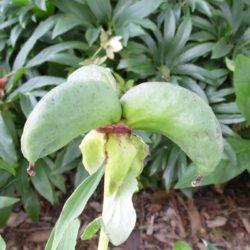
carpel(s)
The principal part of this organ is the ovary of the peony flower, a capsule protecting the ova, (eggs) leading to a pod bulging with seeds when ova are successfully fertilized. In peony flowers, carpels normally occur in clusters, but remain separate, not united (each is pollinated separately). Peonies may have 1 to 4 or more carpels.
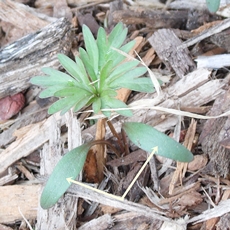
cotyledon (seed leaf)
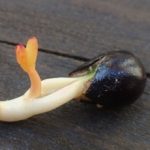 An embryonic leaf in seed-bearing plants, one or more of which are the first leaves to appear from a germinating seed. All peonies have cotyledons, but not seed leaves. In most peonies the cotyledon remain enclosed in the thick seed coat and serve as an energy/water reservoir for the developing seedling. Paeonia tenuifolia and certain indivuals from the Paeonia rockii complex commonly grow seed leaves from cotyledons.
An embryonic leaf in seed-bearing plants, one or more of which are the first leaves to appear from a germinating seed. All peonies have cotyledons, but not seed leaves. In most peonies the cotyledon remain enclosed in the thick seed coat and serve as an energy/water reservoir for the developing seedling. Paeonia tenuifolia and certain indivuals from the Paeonia rockii complex commonly grow seed leaves from cotyledons.

crown
A structure in peonies which is capable of producing both roots and vegetative buds. This structure often appears to be a widened area of root in which buds and roots are attached. Peonies are actually divided through crown division and not “root” division, as most roots are not capable of producing vegetative buds. Both herbaceous and woody peonies have crown tissue; woody peonies have stems which are a basic arial extension of the crown.
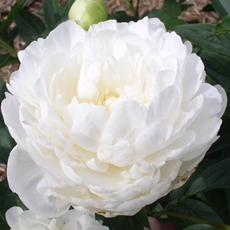
cultivar
A peony produced in cultivation which was selected for any of a number of traits. Cultivars are unique and must be propagated vegetatively to produce the same plant and flowers as the original (seeds from a given cultivar will not grow to become the same plant). Cultivars are usually identified by a specific name, which is unique. The APS Peony Registry contains registered peony cultivars.
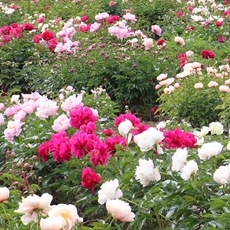
cultivar groups (Peony Registry)
APS, as the International Cultivar Registration Authority, makes use of 6 groups for registered cultivars of peonies. Taxonomists and other entities may use different groupings which suit their their needs specifically. The groupings are determined by information supplied by the registrant and is recorded by the registrar.
The following groups are recognized by APS for registered cultivars:
- Lactiflora Group
- Herbaceous Hybrids
- Suffruticosa Group (includes P. rockii hybrids)
- Lutea Hybrid Group
- Itoh Group & Intersectionals
- Species Selections
For further information click HERE
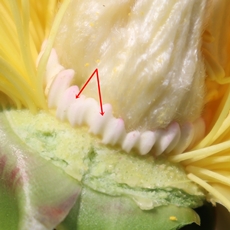
disk
A flower structure found at the base of the carpels. A disk may or may not be present, depending upon a cultivar’s genetic makeup. Disk structure is variable from cultivar to cultivar and may consistent of tiny projections, flattened surface or incomplete. Woody peonies do not have disks, but rather a sheath.
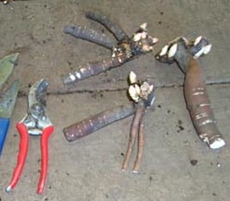
division
Division may be in reference to the practice of dividing, or a single propagule produced through dividing a plant. A progule (division) is made up of supporting roots, crown and dormant buds. Herbaceous peonies most often are propagated through division. Woody peonies may also produce divisions when adequate root and crown material is in proportion.

dormancy
The suspension of normal growth function by peony plants and seeds. This is often referred to as a resting state, but chemical changes are occuring in peonies during this period which are important to their growth.
Seeds in peonies have double dormancy. To break dormancy in peony seeds a period of warmth, then cold followed by warmth is required for growth.

eye(s)
See “bud – vegetative”
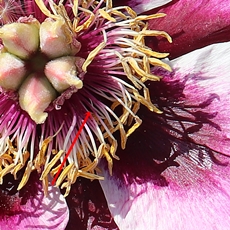
filament(s)
Stamens are made up of a pollen bearing anthers supported on small stems called filaments. A filament is sometimes
more than one color, with the lower portion (base) often darker than the upper half.
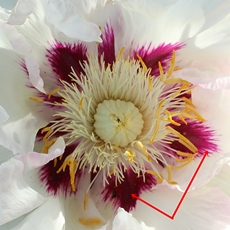
flare
An interior or upfacing marking found at the base of flower petals. Flares are most often associated with woody peonies, but may also be present in herbaceous peonies. Markings found on the outside of petals are known as bloctches – see blotch.

garden named
Naming of a peony which is not a registered cultivar. Typically “garden named” plants were grown from seed and given a name in the garden in which they were grown. These plants are sometimes available in commerce, but are not found in the International Cultivar Registry, which the APS maintains. Some hybridizers of new plants release garden named plants with no intention of registering them, thus they have no historical information for the general public to use. Garden named plants often cause problems in commerce, as buyers of these peonies will not have easily accessible information available. Since peonies live for a very long time garden named plants may also persist for many decades, causing identification problems long after they were named. Garden named plants are recognized as “seedlings” since they lack provenance.
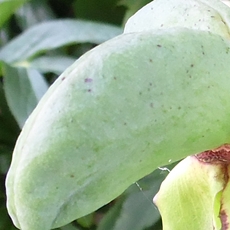
glabrous
Lacking hairs or smooth. Usually used to describe the characteristics of carpels in peonies which lack hairs.
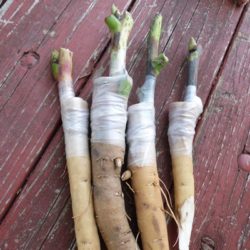
graft
The joined product of stem to root, as often seen in available woody peonies.
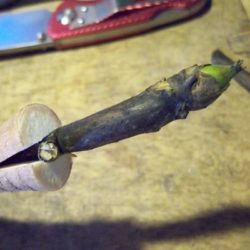
grafting
Commonly used process to propagate woody peonies, in which a scion (stem) is usually joined to a herbaceous peony’s root to produce a graft.
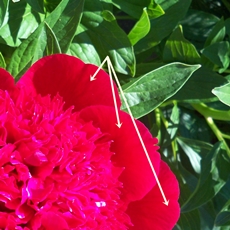
guard petal(s)
The large petals found at the base of a peony flower. These petals are often plate-like, but may be ruffled. Not all peonies express notable guard petals. Name “guard petal” as they protect the interior of the flower when closed or during formation.
